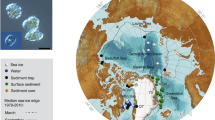Abstract
Diatoms, radiolarians, silicoflagellates, ebridians and archaeomonads are the primary groups of pelagic organisms in siliceous marine deposits, with only the archaemonads regarded as being absent from modern oceans and sediments. They remain a poorly known group of siliceous nanofossils in Cretaceous to Upper Tertiary marine sediments. We present here the first report, from any modern oceanic environment, of pelagic cysts that conform to the descriptions for Archaeomonadaceae. These cysts occurred in seawater, sea ice and marine-surface sediments, demonstrating the group is still extant. Furthermore, their distribution in modern sediment suggests they may be useful guide fossils for sea-ice environments as they occur abundantly only in polar or near-polar water where sea ice is present. Few other microorganisms seem to have such a close and exclusive association with sea ice, thus archaeomonads deserve increased attention as indicators of ice conditions for deep-water marine environments.
This is a preview of subscription content, access via your institution
Access options
Subscribe to this journal
Receive 51 print issues and online access
$199.00 per year
only $3.90 per issue
Buy this article
- Purchase on Springer Link
- Instant access to full article PDF
Prices may be subject to local taxes which are calculated during checkout
Similar content being viewed by others
References
Cornell, W. C. Proc. North American Paleontological Convention, 958–965 (1969).
Stradner, H. in Plankt. Conf. Sec. Rome, 1970 Proc.: Roma (Tecnoscienza) (ed. Farinacci, A.) 1183–1199 (1971).
Deflandre, G. C.r. hebd. Séanc. Acad. Sci., Paris 194, 1859–1861 (1932).
Deflandre, G. C.r. hebd. Séanc. Acad. Sci., Paris 194, 1273–1275 (1932).
Bourrelly, P. Ann. N.Y. Acad. Sci. 108(2), 421–429 (1963).
Deflandre, G. & Deflandre-Rigaud, M. Fichier micropaleont. gen. 19, 4173–4400 (1970).
Tynan, E. J. Plankt. Conf. Sec. Rome, 1970 Proc.: Roma (Tecnoscienza) (ed. Farinacci, A.) 1225–1230 (1971).
Gritten, M. M. Hydrobiologia 53, 239–252 (1977).
Adam, D. & Mahood, A. D. Bull. geol. Soc. Am. 92, 839–844 (1981).
El-Sayed, S. Z. in Biology of the Antarctic Seas Vol. 4 (eds Llano, G. A. & Schmitt, W. L.) (American Geophysics Union, Washington DC, 1971).
Hentschel, E. Wiss. Ergebn. dt atlant. Exped. ‘Meteor’ 10, 151–364 (1932).
Silver, M. W., Mitchell, J. G. & Ringo, D. L. Mar. Biol. 58, 211–217 (1980).
Foster, T. D. & Middleton, J. H. Antarct. J. U.S. 13, 82–83 (1978).
Litsitzin, A. P. in Micropalaeontology of Oceans (eds Funnell, B. M. & Reidel, W. R.) (Cambridge University Press, 1971).
Sancetta, C. Science 211, 279–281 (1981).
Perch-Nielsen, K. Init. Rep. DSDP Leg 29, 873–908 (1974).
Perch-Nielsen, K. Init. Rep. DSDP Leg 38, 147–176 (1976).
Author information
Authors and Affiliations
Rights and permissions
About this article
Cite this article
Mitchell, J., Silver, M. Modern archaeomonads indicate sea-ice environments. Nature 296, 437–439 (1982). https://doi.org/10.1038/296437a0
Received:
Accepted:
Issue Date:
DOI: https://doi.org/10.1038/296437a0
This article is cited by
-
Composition and succession of dinoflagellates and chrysophytes in the upper fast ice of Davis Station, East Antarctica
Polar Biology (2006)
-
Ice diatom floras, Arthur Harbor, Antarctica
Polar Biology (1987)
Comments
By submitting a comment you agree to abide by our Terms and Community Guidelines. If you find something abusive or that does not comply with our terms or guidelines please flag it as inappropriate.



